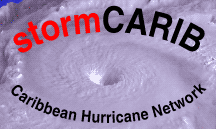
 |
Press Release |
|
|
"U.S. mainland amid respite from hurricanes" (Source: USA TODAY, 5/30/02) MIAMI ^× Atlantic hurricane season starts Saturday, and the U.S. mainland is overdue for a hit. The last several years have been more active than average in terms of the number of hurricanes forming at sea. Yet two years have passed without one hitting the U.S. coastline. Forecasters say the uncommon streak of good fortune, due in part to a stubborn weather trough steering storms away from the East Coast, can't hold forever. "We've basically been lucky. And we shouldn't expect to go on being lucky," says Hugh Willoughby, hurricane research division director for the National Oceanic and Atmospheric Administration. The longest period on record without a U.S. landfall: from 1980 to 1983 ^× three years, seven days. NOAA experts say the Atlantic hurricane season will have a normal to slightly above-normal level of storm activity, with nine to 13 tropical storms, six to eight of which becoming hurricanes. They predict two to three major storms. The season lasts through Nov. 30. On Friday, hurricane forecaster William Gray of Colorado State University is expected to revise downward his April 5 forecast, which called for 12 named storms, including seven hurricanes. Gray says cooler-than-expected Atlantic Ocean temperatures may be less favorable for storms. Hurricane forecasters for the Central Pacific region, which includes Hawaii, also expect more activity, with six to seven storms forming, instead of the average four to five. Meteorologists, who speak of hurricane trends over decades, believe we're in a heightened storm period. Regular changes in ocean temperatures and climate patterns help shape these active and slower cycles. Since 1995, the number of storms in every season but one has exceeded the average. Typically, 10 tropical storms form during the Atlantic hurricane season. Six of those intensify into hurricanes, storms with winds of at least 74 mph. And, on average, two strengthen into major hurricanes, with winds greater than 111 mph. The powerful storms inspire both fear and fascination. The Arawak tribes of the Caribbean called them "hurakan," for evil spirit. William McKinley, while president from 1897 to 1901, said a hurricane was more fearsome than the Spanish Navy. Modern forecasters worry about the potential for more damaging storms because the coastal population has mushroomed in the past two decades from 40 million to 50 million people. And many coastal residents are hurricane novices. Yet, one of the biggest hurricane myths is that only coastal residents should be concerned. Even though storm surge is historically the biggest killer during hurricanes, far more people have died inland in the past three decades as a result of flooding triggered by heavy rains associated with hurricanes. National Hurricane Center researchers studied 600 U.S. hurricane deaths from 1970 through 1999 and found: Flooding from rain claimed 351 lives. High winds killed 71. Six drowned in storm surge. Another myth is that a tropical storm is a hurricane's puny cousin and easy to ignore. Last June's Tropical Storm Allison caused 41 deaths in six states. Damages topped $5 billion. The hardest wallop was in Houston, where 45,000 homes and businesses were devastated. Then Allison, which never became a hurricane, drenched areas from New Orleans to Boston. Given such destruction, it's no surprise humans have long yearned to curb hurricanes. Ancient tribes made offerings, while atomic scientists dreamed of busting them up with nuclear bombs. Neither succeeded. Hurricanes release energy equivalent to a 10-megaton nuclear bomb exploding every 20 minutes, experts say. Dropping a bomb into the maelstrom would be like tossing marshmallows to stop a freight train ^× not to mention the radioactive fallout. The bomb notion was eventually discarded, as was the idea of towing in icebergs to cool the warm oceans where hurricanes gain strength. Homeowners also have some misguided hurricane notions. They crisscross windows with masking tape, a process that doesn't prevent shattering glass but does produce sun-baked Xs that are impossible to remove. They stock up with steaks and other supplies, not realizing power failures mean spoiled refrigerated food. Throwing hurricane parties as a storm approaches grew less common after the devastation caused a decade ago by Hurricane Andrew, which hit southern Florida and Louisiana, flattened 125,000 homes and claimed 26 lives. But such parties are becoming fashionable again. The National Hurricane Center's director, Max Mayfield, points to "hurricane amnesia" if a few years pass without a destructive storm. "It just takes one hurricane over your community to make it a very bad year," he says. //end//
Back to Homepage